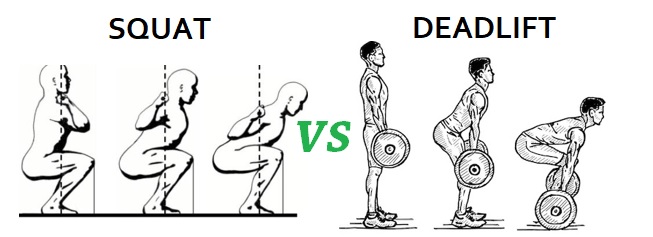“Deadlift the bar.”
“No. DEADLIFT the bar. Don’t squat it.”
“… You’re still squatting the bar.”
“With the hips, man, with the HIPS!”
…
Squats and deadlifts are well-known in the workout world as some of the best all-out strength testers out there. And believe it or not, there IS a difference, and it’s an important one.
We need both.
The Squat LOWERS you to the ground and back up again. You can do this with or without weight.
The Deadlift LIFTS an object (barbell, dumbbell, bag of groceries, child, etc) from the floor, using your body as the lever.
We squat several times a day. Sitting, standing, crouching, etc.
We also deadlift several times a day. Bending over, picking up spilled food or animals or children, or retrieving something within a lower cabinet. So how do you tell the difference? And how do you do them properly? For a squat, think “lower.” For a deadlift, think “hip drive” or “hip thrust.”
Nuances of the Squat:
- Felt mostly in the quads (front of the legs) and glutes (booty cheeks).
- Chest is lifted, neck is long, shoulders are retracted, and feet are typically shoulder-width apart with either feet parallel to one another or rotated outwards at about 12 degrees (see this video to see why food and knee position is important).
- Core is braced on a 2-3 on a scale of 10 to support the lower back.
The Squat Movement, described:
Keeping the spine in adequate alignment (see above paragraph), “break” at the hips, extending them behind you just slightly. Keep your weight towards your heels and mid-foot but still “grip” the floor with your toes. Bend your knees as you lower into the squat. Keep your back straight, and your knees behind or above the toes (unless you’re going ass-to-grass, but otherwise, do not let the knees move in front of the toes). To keep the knees happier still, keep them in-line with your 2nd and 3rd toes. Press into the mid-foot and keep your chest high as you stand back up (don’t let the hips come up first).
Nuances of a Deadlift:
- Felt mostly in the hamstrings (back of the legs) and glutes (booty cheeks).
- Chest is lifted, neck is long, shoulders are retracted, and feet are about hip-to-shoulder-width apart, whichever is more comfortable (also based on the variation).
- Core is braced on a 2-3 on a scale of 10 to support the lower back (maybe more).
The Deadlift Movement, described:
Keeping the spine in adequate alignment (see above paragrah), “hinge” forward at the hips as you reach for the bar. Bend your knees but keep your weight towards your heels, your chest up, and hips higher than your knees.
Maintain a constant retraction on the shoulders, keeping them out of your ears (do not shrug), and “pinch” the bottom of the shoulder blades together. Do not lose your core contraction, as this protects the low back. Grip the bar at shoulder-width, squeeze your lats (the main muscle used to squeeze the shoulder blades together), and THRUST or DRIVE your hips as you pull up on the bar/grocery bag, etc, leading with the chest. Drag the bar up your legs until you can straighten your knees. The weight should be resting against your thighs or hips as you grip it in your hands and you should be able to stand upright without any rounded shoulders, arched backs, protruding stomachs, or aches and pains. Lower it in reverse, keeping the weight as close to your legs as you can. Be sure to sit your hips back behind you and do not move your knees forward (otherwise, it becomes a squat, and a poor one at that).
Contrary to what some say and believe, both are excellent for you. Squats are great for your knees and deadlifts are great for your back. BUT! The trick is to do them right and to practice them daily in your life as you pick up little things and squat in and out of chairs (or on the john!).
If you have any questions, ask!
Now go pick something up.



